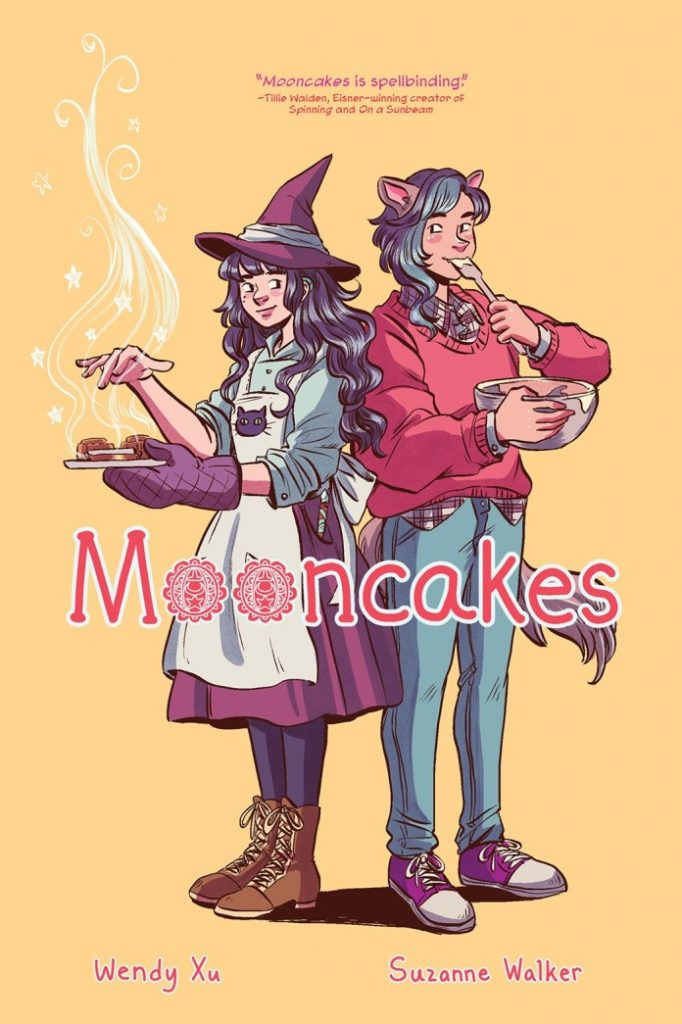
Graphic Novel Review: Mooncakes

By Rebecca Benson
Ever since I first heard about Mooncakes from ROAR/Lion Forge, it piqued my interest. So let’s dive into Mooncakes!
The story, written by Suzanne Walker, begins with Tam’s return to their childhood town. Important to the story is that Tam identifies as nonbinary and prefers the plural pronoun of ‘them’; oh, and is a werewolf. After considerable time apart, Tam is reunited with their friend, Nova. Nova, who is hard of hearing and considers herself ‘queer’, is an apprentice witch. Tam feels at their best and true to themselves at home, with Nova and her grandmothers. Nanas Qui and Nechama have built their bookstore and home with love, acceptance, and understanding. With gentle nurturing and guidance, the Nanas let Nova and Tam find their way to conquer their dilemmas: a horse demon lurking in the forest, finding one’s true identity, and accepting oneself and cultural prejudices. These prejudices are portrayed in Mrs. Crawford, the conformist neighbor, and Tam’s stepdad. Joining the fight is Nova’s best friend and Tam’s former Chemistry lab partner, Tatyana. She is more scientifically inclined and is found to be more of a skeptic, contrasting the world of magic, which includes magical creatures, or “spirits”. Using the forces of magic, love, friendship, and family, Tam must fight the demon within to gain the strength needed to fight the true demon in front of them. The question is, will they succeed?
Artist Wendy Xu and Letterer Jomette Gil add depth and dimension in Mooncakes. The use of color effectively portrays its metaphors and brings meaningfulness to the story. As the story unfolds, colors brighten Tam and Nova are reunited. Tat’s awkwardness is apparent when she is pictured to be aloof. She is sometimes drawn off to the side–more of a third wheel when in the presence of Tam and Nova. When Tam’s flashbacks happen, colors turn to grayscale. The fantastic art stands out when the story is carried on without the use of dialogue. Tat’s belief and acceptance in magic appears when the color scheme shifts yet again towards the end. Panels turn colorless. Again, the art is a story in and of itself, paralleling the idea that the journey is just as important as the destination.
Upon first reading, Tat is portrayed to have a more worldly view. Juxtaposing this ideal are the Nanas’ characteristics. The Nanas are supportive, kind, and caring. They allow Tam and Nova the time it takes to work out problems on their own: both relationally and realistically. There is a strong theme of finding one’s path, with acceptance and encouragement from friends and family. Throughout the graphic novel, it’s apparent that those attributes are what keeps families–no matter the structure–alive. That bond is a lasting one. In each of us are ‘demons’ that need to be conquered; of finding one’s self and what that looks like for everyone. And equally important is the idea that the demon within needs to be conquered to find peace. The novel touches on the power of having a strong connection when Grandma Nechama and Nova practice “nonverbal” magic. Working with the Deaf and Hearing and Hearing community myself, it’s great to see a portrayal of the strength of having to rely on other senses. I enjoyed the novel’s depictions of different family dynamics. It shows that all families are held together in distinctive ways; that love and acceptance are at the core.
Rating: FOUR Pastrami Nations out of FIVE

Rebecca Benson currently resides in the mountains of California. A mother of one daughter, she has a love for pop culture, with a knack for Disney, Harry Potter, and throwback shows from the ’90s. An avid reader, she jumped deeper into the world of comic books in 2020, with her interest piqued in the independent scene.